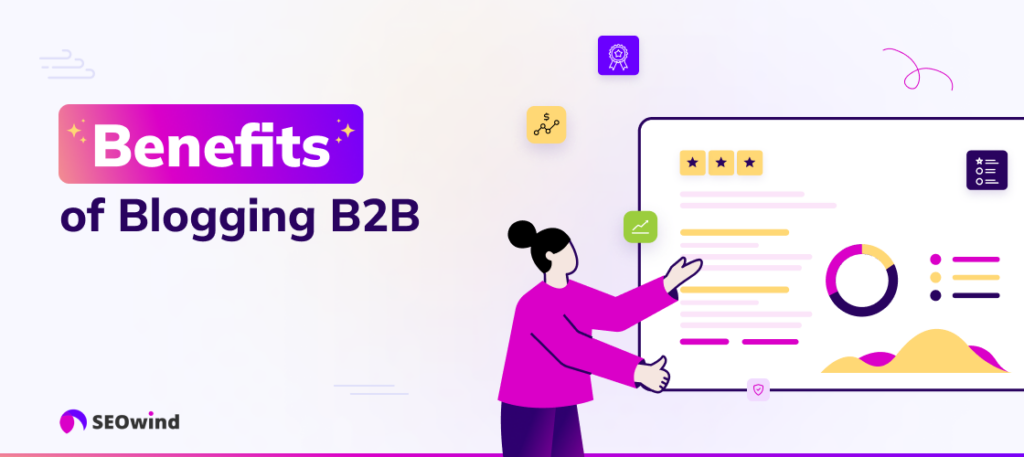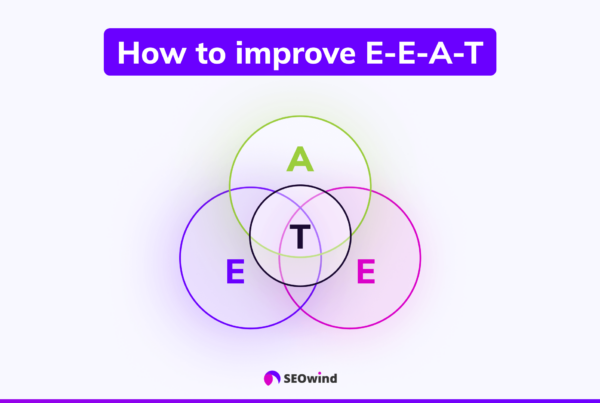Content marketing is essential for businesses to stay relevant and attract new customers. Blogging B2B (business-to-business) stands out as a powerful tool that can help elevate your brand’s online presence and credibility. But what does it take to harness the potential of B2B blogging effectively? This comprehensive guide will provide insights into optimizing your strategy, creating engaging content, measuring success, and ultimately unlocking the full power of B2B blogging.
What is B2B Blogging?

At its core, B2B blogging revolves around publishing written content on your company’s own blog to reach other businesses or professionals instead of individual consumers. The overarching goal: nurturing relationships by providing valuable information tailored to meet the specific needs and solve pressing challenges your target audience faces.
As a result, differentiating factors from traditional consumer-oriented blogging include:
- Commercial focus: Unlike casual blogs for entertainment or self-expression, a b2b blog extends your company’s marketing and sales efforts.
- Target audience: In b2b blogging, your ideal reader may be decision-makers within organizations or individuals with industry experts who seek in-depth knowledge they can apply professionally.
- Content depth: Since b2b readers typically require sophisticated insights that can contribute to their professional growth or augment their organization’s bottom line, b2b bloggers should create well-researched pieces supported by data from reliable sources.
- Tone: Given its specialized purpose geared towards corporate discussions rather than casual engagement with fans or followers like a lifestyle blog might have, a b2b blog maintains a professional tone while still embracing conversational writing
By grasping this fundamental concept behind B2B blogging and its unique characteristics compared to traditional blogs, we set sail to cultivating practical strategies for optimizing and enhancing your b2b blog to improve brand visibility, authority, and customer engagement.
Benefits of Blogging B2B

Increase Visibility and Brand Awareness
Increased visibility is one of the most significant advantages of incorporating b2b blogging into your marketing strategy. A well-crafted b2b blog post with targeted, specific keywords, can improve your organic search results, increasing visibility to potential clients or partners.
Consistently publishing quality content on your b2b blog will allow users to find you organically and establish a strong brand presence within your niche market. By sharing relevant insights and timely industry news, you demonstrate that your company is up-to-date and actively participating in its field. This increased online presence ultimately leads to improved brand awareness, which can result in heightened customer engagement and sales growth.
Create a Library of Content
Another benefit of committing to a regular b2b business blogging schedule is accumulating valuable content over time. As you publish an increasing number of articles on various topics related to your industry, you create a robust library of resources for existing and prospective clients.
This content library serves several purposes:
- It positions you as a thought leader by providing helpful information and solutions.
- Your articles give prospects insight into what working with your business might be like.
- Search engines reward websites with regularly updated and diverse content by awarding higher rankings.
- Blog posts can be repurposed later in email campaigns, downloadable resources, or social media updates.
Each new piece published further enhances the value proposition of engaging with your company blog.
Establish Your Organization as an Industry Leader
A primary goal for many companies investing in b2b blogging is establishing themselves as industry leaders or experts within their niche market. By presenting unique perspectives or helpful tips from knowledgeable team members, you showcase expertise within the organization while reinforcing credibility among the readers. Regularly tackling innovative subjects or topic ideas and providing well-researched opinions on current trends can also contribute to the perception of your organization as a thought leader.
Moreover, publishing insightful articles covering various facets of your industry directly benefits those who interact with your content. This nurtures trust and loyalty among existing customers while demonstrating value to new prospects. The resulting positive perception then sets you apart from competitors as the preferred choice for potential customers and partners seeking guidance and solutions in navigating the complexities of their respective fields.
How to Set Up a B2B Blog

Creating a solid foundation is one of the most essential steps in unlocking the power of B2B blogging. This involves choosing a platform, designing an appealing and user-friendly blog layout and structure, and understanding how to write engaging content. This section discusses these crucial factors that can significantly impact your B2B blog’s success.
Choose a Platform
Selecting the right platform is critical when starting your b2b blogging journey. Here are some popular content management systems (CMS) you may consider:
- WordPress: Known for its flexibility and scalability, WordPress powers nearly 40% of all websites. It offers thousands of themes and plugins, making it one of the most versatile platforms for your b2b marketing blog.
- HubSpot: A popular inbound marketing tool with integrated CMS capabilities, ideal for businesses focused on lead generation and customer engagement.
- Wix: A beginner-friendly website builder offering plenty of design choices and functionalities for businesses starting their b2b blogging venture.
While each platform has unique features, consider what aspects will best cater to your business needs before committing to one.
Design Your Blog
Once you’ve chosen your platform, it’s time to design an aesthetically pleasing and easy-to-navigate environment for your potential readership:
- Layout: Align the look and feel with your organization’s branding while ensuring clean navigation that allows users to access content quickly.
- Relevant Categories: Divide your B2B articles into meaningful categories so readers can easily find appropriate information related to their industry or interests.
- Mobile-responsive design: Since users often consume content from various devices—particularly mobile—it’s essential that your b2b blog seamlessly adjusts itself regardless of screen size or device type.
Write Engaging Content
The final step in setting up your B2B blog involves creating captivating and informative content for your audience. Here are some essential tips to address the interests and pain points of your target readership:
- Research: Investigate current industry trends, customer needs, and competitors’ strategies to create focused and relevant content.
- Speak Their Language: Understand the professional jargon and tone that resonates with your target audience while keeping the text easily digestible.
- Break up Text with Headings and Subheadings: Organize your b2b blog posts using clear headings and subheadings so information is easy to skim through.
- Storytelling: Utilize stories or case studies that highlight real-world examples to make complex concepts accessible, memorable, and valuable.
Following these steps for choosing a suitable platform, designing an intuitive layout, and crafting valuable content provides a firm foundation for building an effective B2B blogging strategy.
Developing a B2B Blogging Marketing Strategy

To truly unlock the power of B2B blogging, your organization must develop and implement an effective strategy. This involves identifying your target audience, setting goals and objectives, and creating a marketing plan and a content calendar. In this section, we will explore these crucial steps in greater detail.
Identify Your Target Audience
For any b2b blogging strategy to be successful, you need first to identify the specific group of people that will find your content relevant and valuable. This is your target audience or ideal reader. Knowing your audience helps you tailor your content to resonate with their needs, interests, and preferences. To identify your target audience:
- Research industry demographics
- Analyze customer data from CRM systems
- Survey existing customers for feedback
- Study competitor blogs’ readership trends
Once you clearly understand who you want to reach with b2b blog content, aim to create content to address their pain points. Share insights and offer solutions to problems they face in the area of expertise where they recognize the value.
Set Goals and Objectives
To succeed in B2B blogging:
- Set measurable goals tied to marketing objectives.
- Track progress using metrics like site visitors and lead generation.
- Use activity-based tactics to achieve goals and drive revenue growth.
- Continuously improve the process with analytics-based decision-making and adjust as necessary for future success.
Create a Content Calendar
Planning and organizing your b2b blog content in advance will substantially improve consistency, quality, and overall effectiveness. Utilizing a content calendar is an ideal way to achieve this:
- Map out your content topics: Determine the key areas that cater to your audience’s interests and concerns. Diversify these topics to keep readers engaged.
- Set frequency and publishing schedule: Align with business goals and available resources and ensure manageable workloads for successful execution.
- Assign responsibilities: Clearly define who is responsible for creating, editing, approving, and promoting each post.
- Outline guidelines for topic research, writing style & tone standards, design & graphics requirements.
A good content calendar leads to better results and trust between team members in b2b blogging. Effective communication, accountability, and teamwork are essential. Expert coordination and optimization of innate skills lead to growth and mastery. The ultimate goal is to achieve personal bests and unlock results-driven rewards. It’s worth the hard work and grinds to leave a unique legacy that touches the lives of millions.
Optimizing Your B2B Blog for Search Engines
You must optimize your blog title and content for search engines to make the most out of your b2b blogging efforts. This will increase the visibility of your blog and help attract a larger audience. This section will discuss important aspects of search engine optimization (SEO), including keywords, headlines and titles, and meta descriptions.
Keywords
Keyword research is a critical element in optimizing your b2b blog for SEO. Incorporating industry-relevant keywords throughout your content can improve your chances of ranking higher on search engine results pages. When selecting keywords, consider the following tips:
- Use tools like Google Keyword Planner or Moz Keyword Explorer to identify high-volume, low-competition keywords relevant to your niche.
- Consider long-tail keywords – these longer phrases with lower search volumes often have less competition and can provide valuable traffic.
- Include primary and secondary keywords throughout your posts naturally. Aim for 3-5 of the appropriate clustered keywords from the list above per each writing section.
Remember not to overstuff your content with keywords, as this can lead to penalties from search engines.
Headlines and Titles
An enticing headline or title is one of the most crucial aspects of a successful b2b blog post. A well-crafted headline can compel potential readers to click through and read more about your post. To create effective headlines:
- Keep them concise but informative: Limiting headlines to around 55-60 characters ensures they won’t get truncated in search engine results.
- Use strong language: Words like “essential,” “ultimate,” or “proven” can add an authoritative tone to your title.
- Incorporate relevant keywords: Ensuring target keywords are included within headers/titles demonstrates the post’s relevance to your readers.
- Utilize numbers and lists: These formats grab attention and signal easily digestible content.
Meta Descriptions
A meta description summarizes your blog post that appears beneath the headline in search engine results. This provides an overview for potential readers and signals to search engines what your content is about. To craft a compelling meta description:
- Be concise: Aim for around 150-160 characters so it isn’t cut off within search results.
- Incorporate relevant keywords: Including target keywords demonstrates relevancy to both the audience and search engines.
- Provide a compelling, informative snapshot: Describe the main points and benefits of the content, enticing users to click through and read more.
In conclusion, optimizing your b2b blog for SEO is essential in boosting visibility and attracting a larger audience. By carefully selecting relevant keywords, crafting compelling headlines and titles, and writing engaging meta descriptions, you can unlock your b2b blogging potential and enhance its overall performance in driving traffic and generating leads.
Creating Engaging Content for Your B2B Blog
A successful B2B blog educates and informs, and consistently engages readers. Crafting compelling content involves several key components, including attention-grabbing headings and subheadings, clear focus on the main message, visual elements, concise writing style, thorough optimization of on-page SEO elements, and inclusion of effective calls to action.
Craft Headings and Subheadings
Headings and subheadings are crucial in capturing the reader’s attention and guiding them through your content. To create engaging titles:
- Use powerful and descriptive words that convey the primary subject matter.
- Keep headings short—aim for fewer than 70 characters—and consider using numbers or questions.
- Leverage subheadings to break up text into digestible sections, assisting with clarity and improving overall readability.
This structured approach helps readers quickly identify relevant information within your b2b blogging efforts.
Focus on The Main Message
To make an impact with your b2b blog strategy, maintain focus on the primary message throughout each post:
- Start by outlining a core idea or topic before developing additional supporting points or examples.
- Provide clear context early in the article—ideally within the introduction—to set expectations for what follows.
- Continually tie back to your central theme as you progress through each section; this reinforces vital takeaways and demonstrates value to readers.
By honing in on your main message from start to finish, you’ll establish coherence while ensuring that critical ideas resonate with readers.
Include Visuals
Incorporating visuals enhances user experience by adding variety to otherwise text-heavy posts. Visuals can include images, infographics, charts, graphs, or even videos—anything that effectively supplements your written content:
- Choose high-quality images relevant to your subject matter which complement textual elements without overshadowing them.
- Infographics excel at presenting complex data or concepts in a visually appealing and easy-to-understand format.
- Statistics or charts can demonstrate industry trends, amplifying your message’s credibility.
Thoughtfully choosing multimedia to integrate within your b2b blog will not only break up walls of text but also contribute added depth and context to your posts.
Be Concise and Clear
One of the blogging best practices is keeping your writing concise and clear. Writing with brevity requires:
- Using short sentences (ideally under 15 words) that express a single idea.
- Employing everyday language with minimal jargon—you want information accessible to everyone, including newcomers.
- Eliminating unnecessary words that don’t contribute value or clarification; maintain focus on delivering key points effectively.
Clear communication forges stronger connections with readers, making even complex topics digestible for those new to the subject matter.
Optimize On-Page SEO Elements
Maximizing visibility is crucial in b2b blogging. Employ smart on-page SEO optimization ensures search engines understand what your content entails while driving higher search rankings:
- Strategically use primary keyword(s) throughout headings, subheadings, image alt tags, URLs, and meta descriptions without overstuffing.
- Implement long-tail keywords—more specific phrases—to target niche audiences actively seeking information about your content’s theme.
- Utilize bulleted or numbered lists when appropriate—this assists with readability and enhances the overall presentation.
Promoting Your B2B Blog Posts

Creating compelling content is crucial for a successful B2B blog; however, promotion plays an equally important role in reaching the target audience and maximizing the impact of your efforts. A strategic approach to promoting your B2B blog posts will help you attract more readers, generate more leads, and establish your organization as a thought leader. This section will discuss how to effectively use social media platforms and email marketing campaigns to promote your blog content.
Social Media Platforms
Social media is one of the most powerful tools for promoting b2b blog posts. Here are some best practices for utilizing various social media channels to amplify your content:
- LinkedIn: LinkedIn is undeniably one of the most effective platforms for B2B blogging promotion. Share each blog post on your personal profile and company page, targeting specific groups or followers you may find relevant. Be sure to include custom hashtags related to your industry or topic.
- Twitter: Twitter provides an excellent platform to share links to your blog posts with concise and engaging text snippets (tweets). Regularly tweet links to new b2b blogs and consider using popular industry-related hashtags or tagging influencers interested in sharing the content with their audience.
- Facebook: Create a Facebook business page specifically for your b2b blog if you haven’t already done so, and share all new articles there regularly while tailoring captions and images accordingly.
- Instagram: Although Instagram may not seem an obvious choice initially for B2B marketing blogs, visuals play a vital role in capturing users’ online attention. Highlight key points from blogs through visually appealing images or create short video clips highlighting valuable information you want readers to learn from.
- Niche Forums & Communities: Posting links strategically in online niche forums or specialized communities allows you to target those who have demonstrated an interest in your topic. Participate actively in industry-specific discussions to build credibility before sharing your blog content.
Remember that consistency is critical when using social media platforms for promotion – scheduling regular updates and maintaining a solid presence will garner better results over time.
Email Marketing Campaigns
Email marketing remains an effective method of promoting b2b blogging content, mainly because it allows businesses to target subscribers who have explicitly demonstrated an interest in their offerings or specific topics. Here are some strategies to leverage email to drive traffic to your B2B blog:
- Include Blog Links in Newsletters: Share links to recent b2b blog posts within your company’s regular newsletters, ensuring the subject line is attention-grabbing while keeping the email body concise and engaging.
- Dedicated Emails: Occasionally send an email focused exclusively on a single high-impact post or topical series that you believe holds exceptional value for subscribers. Provide a brief preview of the content and articulate why they should read further by clicking through.
- Segment Lists: Segment your email lists based on reader preferences, engagement levels, and other factors, allowing you to tailor blog promotions specifically for each segment’s interests and expected outcomes.
- AB Test Emails: Experiment with various elements of your promotional emails, such as subject lines, send times, and formatting options; analyze results consistently so that refinements can be made continuously for enhanced effectiveness.
By incorporating these tactics into your broader digital marketing strategy, you can unlock the potential of b2b blogging.
Advanced Promotion Tactics
Enhancing the reach of your B2B blog goes beyond merely sharing it on social media or through email marketing. To unlock the potential of your B2B blogging efforts, consider incorporating these advanced promotion tactics to gain a competitive edge and expand your audience.
Utilize Industry Forums and Communities
Participating in industry forums, question-and-answer websites (like Quora), and professional communities such as LinkedIn groups can help you share your knowledge while promoting relevant B2B blog posts to an engaged target audience. By actively participating in these discussions and offering valuable insights and links to related content, you can build trust within the community and boost traffic to your b2b blog.
Repurpose Content for Alternative Formats
Repurposing existing content into different formats helps broaden its reach and create additional engagement opportunities. Consider turning one of your popular blog articles into:
- Infographics
- SlideShare presentations
- Podcast episodes
- Video content Thanks to this, you can appeal to various learning styles and extend your reach across multiple platforms.
Publish Syndicated Content on Leading Publications
Syndicating some of your best b2b blog posts on prominent publications in the industry is another effective promotional tactic. Platforms like Medium, Business 2 Community, or industry-specific outlets provide an excellent opportunity for republishing content that has already performed well on your website. This strategy increases visibility and exposes your brand to new audiences who may become loyal followers.
Leverage Social Bookmarking Sites
Social bookmarking sites like Reddit, Digg, or StumbleUpon offer an alternative way for readers to discover interesting content online. Submitting quality b2b blog posts to social bookmarking websites relevant to your niche increases the likelihood of attracting targeted traffic from readers searching for material similar to what you have written about in the post.
Partnership Marketing
Collaborate with non-competing businesses or organizations in the same industry and co-promote each other’s content. This tactic can include guest blog exchanges, partnering for a joint webinar, or mentioning each other on social media. Partnerships help extend your reach to new audiences, amplify the impact of your content, and add credibility to your b2b blogging efforts.
Adopting these advanced promotion tactics will elevate your b2b marketing blog’s visibility and accelerate its growth. The key is to develop an integrated approach that combines multiple strategies tailored to meet the demands of your target audience and align with your business objectives.
Measuring the Success of Your B2B Blogging Efforts

To fully unlock the potential of B2B blogging, measuring and evaluating your blog’s performance is crucial. Assessing your blog’s impact on specific business outcomes will enable you to understand what works and what doesn’t, allowing you to refine and improve your strategy over time. In this section, we’ll explore some key metrics and tools that can help monitor the success of your B2B blogging efforts.
Analytics Tools
The right analytics tools are essential for collecting data on user interaction with your b2b blog. A few popular options include:
- Google Analytics: This powerful tool provides comprehensive insights into user behavior, such as visitors’ demographics, traffic sources, pages per session, bounce rate, duration spent on site, conversions, and more.
- Moz Pro: Moz Pro is a suite of SEO tools that allows you to monitor site visibility in search engine rankings by tracking keyword rankings and discovering link-building strategies.
- HubSpot: HubSpot is an all-in-one marketing platform that offers detailed analytics on content performance so that you can track lead generation through CTAs (Call-to-Actions) embedded in posts.
- Ahrefs: This platform contains invaluable features like backlink analysis, keyword research, competitor monitoring, and content gap analysis – helping optimize overall b2b blog strategy.
Ensure you choose a tool or multiple tools tailored to your organization’s needs and objectives for accurate data collection and valuable insights.
Traffic, Clicks, and Conversions
When measuring the success of your b2b blogging efforts, focus on these core areas:
Total Website Traffic
Monitor visit frequency by unique visitors and page views per session gained from posting informative blogs about the industry area – which could generate traffic and ultimately lead to increased brand engagement.
Organic Search Traffic
Examining organic search traffic helps assess the effectiveness of your blog’s SEO (Search Engine Optimization). Tracking organic traffic performance can help you identify opportunities for improvement, particularly by looking up keyword ranking and search volume.
Bounce Rate
Blogs that capture readers’ attention should have a low bounce rate. Analyzing the percentage of visitors who leave after viewing only one page will highlight which blog topics resonate most with your audience or point to any issues with post quality.
Social Media Engagement
Measuring social shares, likes, comments, and retweets illustrates how successful your promotion strategy is in spreading brand awareness across various platforms.
Click-Through Rates (CTR)
Knowing CTRs on CTAs ensures they’re effectively positioned and relevant enough to encourage leads to fill out forms or initiate contact – thus contributing towards business growth through higher conversion rates.
Gauging the success of your b2b blogging strategy periodically allows you to optimize content and marketing plans accordingly. By using analytics tools and focusing on critical metrics such as total website traffic, organic search traffic, bounce rate, social media engagement, and click-through rates on CTAs, you can refine your approach to improve results continuously.
Advanced Strategies for B2B Blogging
B2B blogging is a highly effective marketing tool that, when done correctly, yields impressive results. To unlock the full power of your b2b blog strategy and gain an edge over your competitors, consider implementing advanced tactics such as guest posting and collaborations with influencers.
Guest Posting
Guest posting involves publishing articles on relevant websites or industry blogs with a larger audience than your platform. This approach can bolster your credibility, drive more traffic to your b2b blog, and expand your reach in the market space.
To capitalize on guest posting for b2b marketing blogs:
- Begin by identifying authoritative sites within your industry where guest posts are accepted.
- Tailor pitches specifically for each site you target, ensuring they resonate with the editorial team and readership.
- Craft high-value content that showcases your expertise and directly benefits the host website’s audience.
- Provide clear calls-to-action directing their audience back to your b2b blog through embedded links.
Effective guest posting requires adherence to blogging best practices, such as optimizing for SEO and delivering substantive value to readers, so take time to hone these skills before approaching other platforms.
Collaborations with Influencers
Influencer marketing has become a powerful force in today’s digital landscape, particularly as long-established trust in celebrities or large companies dwindles in favor of more authentic online personalities offering tried-and-tested advice or recommendations. By partnering with influencers who cater to your target market segment, you multiply the impact of your b2b blogging efforts exponentially.
To launch successful influencer collaborations on a b2b blog:
- Identify potential partners whose audiences align closely with yours, then gauge their engagement levels (i.e., likes, comments), authenticity (e.g., whether sponsored posts are disclosed), and relevance (i.e., how well their messaging mirrors yours).
- Reach out to them, proposing mutually beneficial partnerships, such as co-authored blog posts or video collaborations, which showcase their unique expertise and bolster your credibility within the industry.
- Brainstorm content concepts that inspire and captivate both of your audiences, staying true to the core values you share.
- Amplify your combined reach by cross-promoting each other on social media platforms in an organic way.
While these advanced strategies involve more time and dedication than regular b2b blogging practices, they hold immense potential for driving traffic and generating greater awareness about your brand. By establishing mutually beneficial relationships with guest post hosts and relevant influencers, integrating these tactics into your b2b blog strategy will maximize return on investment while positioning your business at the forefront of industry trends.
Common Mistakes to Avoid in B2B Blogging

Navigating the world of B2B blogging can be challenging, and it is essential to avoid common mistakes that could hinder your growth and damage your brand’s reputation. In this section, I’ll cover some of the most prevalent mistakes made by B2B bloggers and provide advice on how to sidestep them for a more successful blogging experience.
Neglecting the Needs of Your Audience
One crucial error many b2b bloggers make is failing to focus on their target audience’s needs. B2B blogging should always prioritize delivering valuable information tailored to address specific pain points or answer pressing questions. To avoid this mistake:
- Regularly communicate with your readers
- Conduct industry research
- Monitor trends and hot topics
Overemphasis on Self-promotion
While promoting your products and services is a natural part of any marketing endeavor, excessive self-promotion on your B2B blog may deter prospects seeking knowledge. Focus on providing value first, as this will ultimately lead customers towards your products and services organically over time.
Inconsistency in Posting Frequency
An inconsistent posting schedule is another common mistake in b2b blogging. A sporadic approach may result in lost followers or potential leads due to a lack of engagement. Develop a content calendar indicating regular intervals to publish new content.
Publishing Subpar Content
The quality of the content published on b2b blogs significantly impacts reader satisfaction and trustworthiness. Do not rush merely to get a post out; instead:
- Thoroughly proofread articles before publishing
- Invest in quality visuals
- Include data from reliable sources when supporting claims
Ignoring SEO Best Practices
Another key misstep involves neglecting search engine optimization (SEO) best practices vital for increasing visibility in online searches. Remember to:
- Strategically incorporate keywords
- Optimize headlines, titles, and meta descriptions
- Boost internal linking
Disregarding Analytics
Ignoring the insights gained through analytics tools is a missed opportunity when evaluating b2b blogging success. Regularly tracking performance metrics will provide valuable information for refining your content strategy and ensuring a better return on investment (ROI).
To sum up, preventing these common pitfalls in B2B blogging means understanding the needs of your audience, avoiding excessive self-promotion, maintaining consistency in posting frequency, prioritizing high-quality content, implementing proper SEO strategies, and making informed decisions based on key metrics. By steering clear of these mistakes and focusing on offering value to your target audience, you can unlock the true potential of B2B blogging for your organization.


